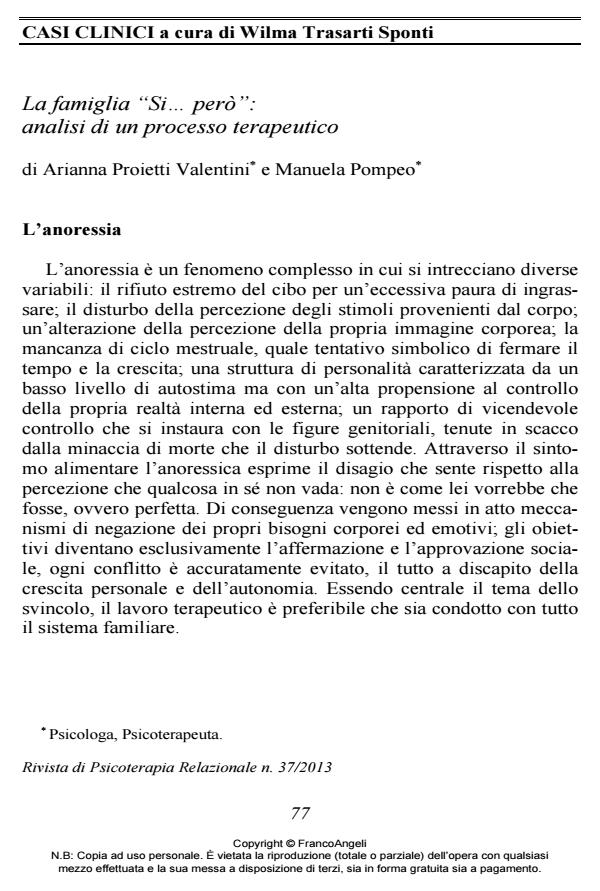The family "yes ... But": analysis of a therapeutic process
Journal title RIVISTA DI PSICOTERAPIA RELAZIONALE
Author/s Arianna Proietti Valentini, Valentina Pompeo
Publishing Year 2013 Issue 2013/37 Language Italian
Pages 16 P. 77-92 File size 407 KB
DOI 10.3280/PR2013-037004
DOI is like a bar code for intellectual property: to have more infomation
click here
Below, you can see the article first page
If you want to buy this article in PDF format, you can do it, following the instructions to buy download credits

FrancoAngeli is member of Publishers International Linking Association, Inc (PILA), a not-for-profit association which run the CrossRef service enabling links to and from online scholarly content.
This work represents a small contribution to the understanding of the complex relational reality characterizing the dynamics in place within families Anorexics. The underlying hypothesis from which we start is that there are no anorexic patients but anorexic systems, where one Member is spokeswoman, through the symptoms of discomfort felt by all. The introduction of the idea that each person’s diversity is a resource available to all, allowed the disbanding of those relational nodes kept standing by the myth of the family unit. The unveiling of the emotions, and the setting of new relational modes and communication have facilitated the evolution of that process of finding that starting on the other creates the identity of each.
Keywords: Anorexia, triangulation, restructuring, emotion, metaphor
- Bruch H. (2003). La gabbia d’oro. L’enigma dell’anoressia mentale. Milano: Feltrinelli.
- Bruch H. (1988). Anoressia. Casi clinici. Milano: Raffaello Cortina Editore.
- De Francisci A., Piersanti T. (2006). La famiglia tra vincoli e risorse. Percorsi terapeutici complessi. Milano: Franco Angeli Editore.
- Loriedo C., Picardi A. (2000). Dalla teoria generale dei sistemi alla teoria dell’attaccamento. Percorsi e modelli della psicoterapia sistemico-relazionale. Milano: Franco Angeli Editore.
- Marzano M. (2011). Volevo essere una farfalla. Roma: Mondadori.
- Minuchin S., Fishman H.C. (1982). Guida alle tecniche della terapia della famiglia. Roma: Astrolabio Editore.
- Onnis L. (2005). Il tempo sospeso. Anoressia e bulimia tra individuo, famiglia e società. Milano: Franco Angeli Editore.
- Selvini Palazzoli M., Cirillo S., Selvini M., Sorrentino A.M. (1988). I giochi psicotici della famiglia. Milano: Raffaello Cortina Editore.
- Selvini Palazzoli M. (2006). L’anoressia nervosa. Milano: Raffaello Cortina Editore.
- Selvini Palazzoli M., Boscolo L., Cecchin G., Prata G. (2003). Paradosso e controparadosso. Milano: Raffaello Cortina Editore.
- Ugazio V. (1998). Storie permesse Storie proibite, polarità semantiche familiari e psicopatologie. Torino: Bollati Boringhieri.
Arianna Proietti Valentini, Valentina Pompeo, La famiglia "Si" però": analisi di un processo terapeutico in "RIVISTA DI PSICOTERAPIA RELAZIONALE " 37/2013, pp 77-92, DOI: 10.3280/PR2013-037004